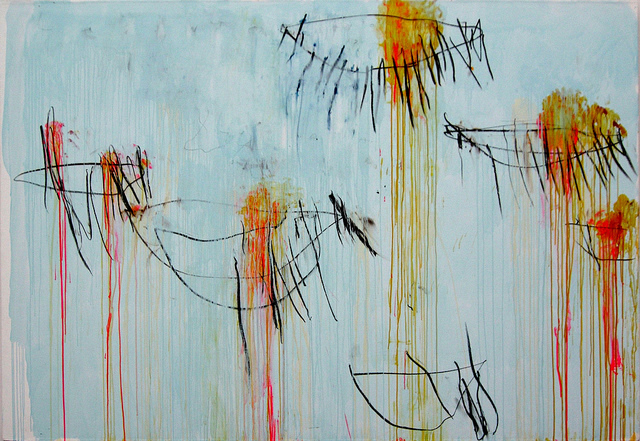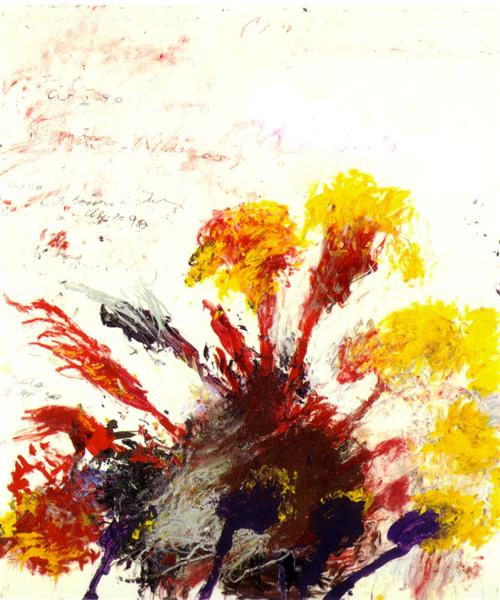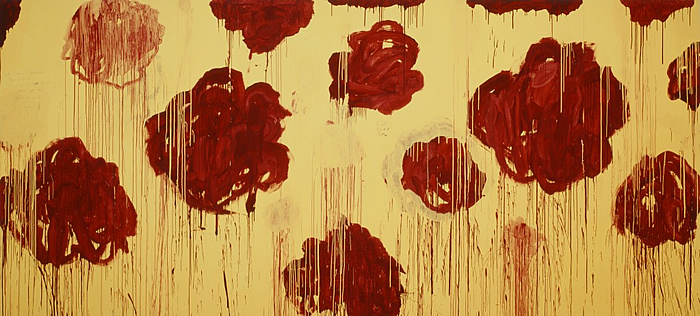American painter, sculptor, and photographer Cy Twombly was renowned for his unique aesthetic that united minimalism and abstract expressionism. Twombly, born in Lexington, Virginia, in 1928, attended the Art Students League of New York and the School of the Museum of Fine Arts, Boston, before going to Europe and seeing the works of European masters. The expressive brushstrokes, scribbled lines, and incorporation of text, symbols, and literary and mythological allusions distinguish Twombly’s artwork. His works commonly contain layers of colour and marks that convey movement and emotion. Though they seemed spontaneous at first glance, Twombly’s paintings were typically highly cerebral, delving into issues of memory, time, and the human condition.
Twombly gained significant recognition for his contributions to modern art during his career. As one of the most significant artists of the 20th century, Twombly passed away in 2011, yet his works are housed in important collections and museums worldwide.
Twombly has a unique and avant-garde aesthetic. He combined minimalism, graffiti art, and abstract expressionism to develop his visual language. His paintings frequently questioned conventional ideas of painting and drawing by using expressive gestures, graffiti-like lines, and scribbles. Even though Twombly’s paintings appear impromptu and disorganised, they frequently have great emotional depth. He arouses feelings in spectators and asks them to decipher the meaning behind his sculptures through gestures, phrases, and symbols.

Classical mythology, literature, and poetry significantly impact Twombly’s writing. He frequently added words and allusions to historical civilizations to his paintings, adding layers of significance that appeal to viewers’ minds and emotions. Twombly’s impact can be observed in many modern artists’ works. His research of the relationship between text and picture and his willingness to try new mediums and methods have encouraged later generations of artists to push the limits of artistic expression.
Twombly’s work garnered considerable critical recognition during his career. He was praised for his willingness to push the boundaries of artistic expression and his capacity to communicate nuanced emotions with seemingly straightforward movements.
Art of Cy Twombly
American artist Cy Twombly (1928–2011) is regarded as an occult and unapproachable artist. Researchers and viewers face incredible problems with pencil drawings, paint explosions, tumbling lines, overlapping layers of colour, inscriptions, mathematical shapes, digits, rows of numbers, words, quotes in fragments, and mysterious work titles.
Among painters from the 20th and 21st centuries, Cy Twombly is arguably the most “morphomatic.” Nobody else has exerted as much artistic energy in battling the material and intellectual legacies of antiquity and the legacy of global cultures that continue to this day as Twombly has. Nobody else has the same understanding of how to negotiate the boundaries between literature and art, not just as a side project but as one of his main artistic goals. Furthermore, no one else has made an equally strong effort to preserve and critically examine the continued use of “old” figurations in the spirit of contemporary art for the modern era.
‘Taking an interdisciplinary approach to American artist Cy Twombly is a fascinating challenge. Throughout his considerable oeuvre, Twombly works time and again with various allusions to, borrowings from, and reflections upon artistic genres, lyric texts, and mythological tales. His work is described as hermetic and contrasted with the main currents of mid-twentieth-century art. In actuality, however, he responds very sensitively to numerous inspirations, positioning himself in a highly reflective manner about his contemporaries and classic modernist art history, writes Richard Hoppe Sailer.

According to Richard Hoppe Sailer, Twombly’s oeuvre, many works deal with how, after the history of abstraction, it is possible to refer to the old pictorial themes of myth. When paintings with allusions to the landscape are observed, this occurs because it is precisely in landscape painting, far removed from more traditional and textually determined subjects, that abstraction methods can be successfully demonstrated. At the same time, these paintings by Twombly reveal an interest in the history of art and his process of adapting it, and they are suited to the explication of an aesthetic concept in which ideas about process play a central role. This is where the methodological problem described at the outset arises: The symbolic elements of the paintings recede to the background; their significance to the evocation of landscape or mythology is set aside in favour of the investigation of the process of a natura naturans, or they are critically considered traditionally in terms of their potentially iconographic content.
Each visual figuration selects an aesthetic region from the entire visual universe to provide a unique meaning, just as the landscape portrays an ever-changing aesthetic grasp of nature and makes it readable and tame. The observer perceives nature as an open field where he can bring order by perceiving. These orders could be in a variety of forms. They can go forward per the subordination pattern; alternatively, they can define an extract as constantly changing and capture the scope of a landscape in a paratactic series. Through his composition, Twombly provides the audience with a vivid reproduction of these modalities. By doing this, he willfully avoids prioritising any location or geographic determination.
According to Twombly, nature is similar to the landscape, literally as a landscape structure in the minds of a very different generation of pictures and metaphorically as the topography of significations. In his reflections on Twombly, Roland Barthes brought to the foreground and characterised the process with clumsiness (gaucherie). These delineated forms of a radical openness in pictorial structure, coupled with a simultaneous, internal, high degree of perceptual complexity, are the prerequisite for such a process.

‘Twombly’s artworks appeared foreign—not so much because the artist settled in Italy in 1957, but because the meaning and power of his paintings and sculptures were neither limited nor exhausted by the possibilities of these media alone. Speaking about his works, Twombly admitted that his art productions did not fit the trend of American Modernism, which is how art achieved ‘purity’ by eliminating the specific effects of painting and any and every possible borrowing from the medium of any other art. “I’m not a pure; I’m not an abstractionist completely. There has to be a history behind the thought.” If a trend in recent art was to achieve meaning by an open and obvious engagement with the restrictions of the support while forbidding any attempt to refer the problem to any other compartment of art, Twombly’s visual work addressed concerns shared with both the art of writing and the art of thinking. Because the art of writing, like visual art, belongs simultaneously to the process of seeing and thinking, it adds new dimensions to Twombly’s work. It is at once visual and intellectual. Moreover, Twombly’s work offers a good vantage point for reconsidering the relationship between seeing and thinking to the extent that his art attempts to attach a temporality to the act of seeing, writes Adriana Bonta.
The inclusion of inscriptions and scrawls on the surface of the works necessitates that these be considered assets of marks in addition to forms and colours. Writing develops through the configuration and arrangement of different lines and highlights the support it rests on, just like with abstract shapes. However, in this instance, the support alludes to more than simply the canvas’s flat surface.
Through the physicality of paint and gesture, Cy Twombly’s art invites viewers into a universe where emotions, memories, and narratives collide. His works transcend traditional limits. Twombly evokes reflection and contemplation by capturing the essence of the human experience through his unique blend of calligraphy and abstraction. His art invites viewers to investigate the relationship between chaos and order, beauty and imperfection, and the intricacies of life. We learn about the depths of the human soul and the power of artistic expression as we explore the mysterious world of Cy Twombly.
A Brief History of Mystical ”Seven Magic Mountains” of Las Vegas





